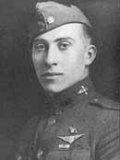James Armand Meissner
| James Armand Meissner | |
|---|---|
|
Maj. James A. Meissner, c. 1919 | |
| Nickname(s) | Jimmy |
| Born |
July 20, 1896 Londonderry, Nova Scotia |
| Died |
January 16, 1936 (aged 39) Birmingham, Alabama |
| Buried at | Arlington National Cemetery (Section 2, Site 4791) |
| Allegiance |
|
| Service/branch |
Air Service, United States Army Alabama National Guard |
| Years of service | 1917–1922 |
| Rank | Major |
| Unit | 94th Aero Squadron |
| Commands held | 147th Aero Squadron |
| Battles/wars |
|
| Awards | Distinguished Service Cross, French Croix de Guerre |
| Other work | Commanding Officer, 135th Observation Squadron, Alabama Air National Guard |
Major James Armand Meissner (1896–1936) was a World War I flying ace credited with eight aerial victories and awarded two Distinguished Service Crosses.
Early life and service
Meissner grew up in Brooklyn, New York and graduated from Erasmus Hall High School there. He enrolled at Sibley College in Ithaca, New York to study engineering. As a member of the college's corps of cadets, he enlisted in the U.S. Signal Corps and was graduated with the first class of the School of Military Aeronautics on 14 July 1917.
Combat service
Meissner completed his aeronautic combat training in Tours and was commissioned a 1st lieutenant on 20 November 1917, after which he reported to the 94th Pursuit Squadron commanded by Major John Huffer. Among his colleagues in the unit were Eddie Rickenbacker and members of the Lafayette Escadrille.
Piloting a French-made Nieuport 28, Meissner scored his first aerial kill over the Forêt De La Rappe on 2 May 1918; he was fortunate to survive, given the fabric was shredding off his top wing even as he scored.[1] At any rate, the feat earned the Distinguished Service Cross and the Croix de Guerre. He shot a second plane down near Jaulny on 30 May, colliding with an Albatros fighter in the process.[1] He then racked up two more kills—one of which he shared with Douglas Campbell—before being made commander of the 147th Pursuit Squadron in July. Now flying a SPAD S.XIII fighter, he scored four more kills, one of which was an observation balloon, and another of which was shared with Ralph O'Neill.[2]
Postwar life
Meissner was discharged as a major on 25 March 1919 and returned to Cornell to complete his master's in engineering. After receiving his diploma, Meissner moved to Birmingham, Alabama and began working at Tennessee Coal, Iron and Railroad Company's rail mill. He married Elva Kessler, daughter of a landscape architect from Augusta, Georgia.
In 1919, he and Henry Badham (father of director John Badham) organized the Birmingham Flying Club, nicknamed the "Birmingham Escadrille" and leased a tract of land near Ensley to set up an airfield (Roberts Field). The club was recognized, with the assistance of Alabama's adjutant general Colonel Hartley A. Moon,[3] as the 135th Observation Squadron on 21 January 1922 under Meissner's command. It was Alabama's first Air National Guard unit and the 7th in the United States. At one time, Meissner was its commanding officer.[1]
Meissner died from pneumonia in January 1936. Rickenbacker made the trip to Birmingham to serve as pallbearer during his memorial service, which was capped by a flyover by members of his unit. His ashes were interred at Arlington National Cemetery the following May.
See also
References
- 1 2 3 Nieuport Aces of World War 1. p. 73.
- ↑ "James Meissner". theaerodrome.com. Retrieved 30 March 2010.
- ↑ Scales, Matt. "James Armand Meissner" (PDF). 117th Air Refueling Wing. Air National Guard. Retrieved 29 December 2011.
Bibliography
- Scales, Matthew H. (January 2009) "James Armand Meissner" at the Arlington National Cemetery Website - accessed March 20, 2010
- "James Meissner" at The Aerodrome website - accessed March 20, 2010
- Nieuport Aces of World War 1. Norman Franks. Osprey Publishing, 2000. ISBN 1-85532-961-1, ISBN 978-1-85532-961-4.
